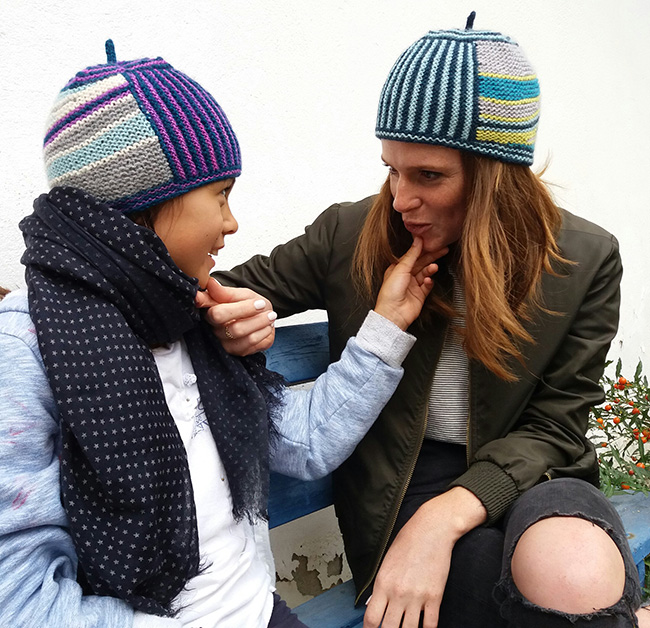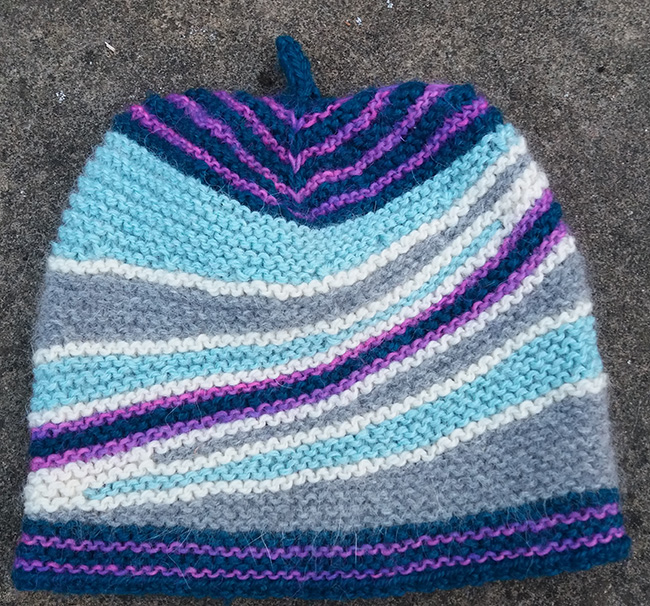NAME, a free knitting pattern from Knitty.com. Free knitting pattern for a DETAILS HERE.
INTRODUCTION
The Werewolf of Westport 
![]()
In the spring of 2016, I knitted a scarf designed by Stephen West, The W, for the Edinburgh Yarn Festival. As I had a few bits of yarn left over, I wanted to make myself a matching hat using the same characteristics as the scarf: garter stitch, stripes, short rows wedges and modular construction. Thus this hat was born, and I thought I should call it The W hat. That said, I found the name a little unimaginative and I looked for an alternative, an alliteration with W, perhaps, and settled for Werewolf. But I wanted to a little more still, and added "Westport", a charming area of Edinburgh. To my great surprise, I then discovered online that "The Werewolf of Westport" was the name of a film written in the Sixties but never made.
The Werewolf of Westport is an excellent leftovers buster, and a perfect last minute gift project.
 model: Clément Bayart, Cécile Conte, Héloïse Etchecopar Atagi
model: Clément Bayart, Cécile Conte, Héloïse Etchecopar Atagi
 photos: Tony Querrec
photos: Tony Querrec
SIZE
One
FINISHED MEASUREMENTS
Circumference: 21.5 inches/54 cm
Height: 8 inches/20cm (customizable)
To customize depth, add extra stripes in the lower border.
MATERIALS
Yarn
![]() [MC] Yarnway Merino Single Light [100% merino; 328 yd/300 m per 100 g skein]; color: Enrico; 1 skein. Sample used 30 m.
[MC] Yarnway Merino Single Light [100% merino; 328 yd/300 m per 100 g skein]; color: Enrico; 1 skein. Sample used 30 m.
![]() [CC1] Triskelion Emrys Aran [100% Blue Faced Leicester; 181 yd/166 m per 100 g skein]; color: Llyr; 1 skein. Sample used 42 m.
[CC1] Triskelion Emrys Aran [100% Blue Faced Leicester; 181 yd/166 m per 100 g skein]; color: Llyr; 1 skein. Sample used 42 m.
![]() [CC2] Filature du Valgaudemar Sable [70% merino, 30% angora; 164 yd/150 m per 50 g ball]; color: Gris chiné. 1 ball. Sample used 24 m.
[CC2] Filature du Valgaudemar Sable [70% merino, 30% angora; 164 yd/150 m per 50 g ball]; color: Gris chiné. 1 ball. Sample used 24 m.
![]() [CC3] Pirkkalanka Paksu [100% finnish wool; 186 yd/170 m per 100 g skein]; color: 101; 1 skein. Sample used 10 m.
[CC3] Pirkkalanka Paksu [100% finnish wool; 186 yd/170 m per 100 g skein]; color: 101; 1 skein. Sample used 10 m.
![]() [CC4] Cheval Blanc Quito [60% wool, 40% alpaca; 109 yd/100 m per 50 g ball]; color: Glacier; 1 ball. Sample used 26 m.
[CC4] Cheval Blanc Quito [60% wool, 40% alpaca; 109 yd/100 m per 50 g ball]; color: Glacier; 1 ball. Sample used 26 m.
Note: This project requires five colors of worsted weight yarn, and is idea for using up leftovers.
Recommended needle size
[always use a needle size that gives you the gauge listed below - every knitter's gauge is unique]
![]() US #6/4mm needles for working flat
US #6/4mm needles for working flat
![]() US #6/4mm needles for small circumference in the round
US #6/4mm needles for small circumference in the round
![]() 1 16-inch/40cm US #4/3.5 mm circular needle
1 16-inch/40cm US #4/3.5 mm circular needle
![]() US #6/4mm crochet hook for provisional cast on
US #6/4mm crochet hook for provisional cast on
Notions
![]() yarn needle
yarn needle
![]() scrap yarn
scrap yarn
GAUGE
20 sts/40 rows = 4 inches/10 cm in garter stitch (unstretched)
PATTERN NOTES
[Knitty's list of standard abbreviations and techniques can be found here.]
Crocheted Provisional Cast on
Using scrap yarn, make a slipknot and place it on the crochet hook. Hold the hook in your right hand and the needle in your left hand. Put the needle between the hook and the working yarn, catch the yarn with the hook and pull it through the loop on the hook. Bring the yarn under the needle. Repeat until you have required number of stitches on the needle, then chain some stitches to secure and break yarn. Attach the project yarn to begin.
When ready for live stitches, undo the extra chain stitches and unravel the crochet chain while picking up the live stitches on the needle.
Short rows technique on garter stitch
Knit the required number of stitches, turn work and knit next row normally.
To close the gap on a RS row, knit to the gap, pick up the bump under the stitch you’ve just knitted, then knit the next stitch together with that bump.
To close the gap on a WS row, knit to the gap, pick up the bump under the stitch you’ve just knitted and pass it to the right hand needle, knit the next stitch and pass the bump over.
Seaming Live stitches to selvedge in Garter Stitch
Fold the WS of the rectangle together in way to face the RS of the short row section. With yarn coming from the back, go up through the first selvedge stitch and pull the yarn. *Go through the first live stitch as if to knit and drop the stitch off. Go through the next stitch as if to purl and pull the yarn. Go down the same selvedge stitch you went up before, and up the next stitch. Repeat from * until you drop off the last live stitch.
S2KPO: slip 2 sts together as if to knit 2 together, knit next stitch, pass 2 slipped sts over.
Note: To minimize the number of yarn ends to weave in, keep yarns attached unless otherwise instructed.
DIRECTIONS

Provisionally cast on 60 sts. Change to MC and larger needle for working flat.
Make 1 ridge in garter stitch as follows:
Row 1 [RS]: K to last st, slp1 wyif.
Row 2 [WS]: K to last st, slp1 wyif. Break yarn
Using CC1, make 1 ridge as before. Break yarn.
Using CC2, work short rows as follows:
Row 1 [RS]: K54, turn work.
Row 2 [WS]: K to last st, slp1 wyif.
Row 3 [RS]: K to 6 before previous turn, turn work.
Row 4 [WS]: K to last st, slp1 wyif.
Repeat Rows 3-4 7 more times.
Using CC3, make 1 ridge as before, closing gaps created by short row turns.
Using CC4, work short rows as follows:
Row 1 [RS]: K50, turn work.
Row 2 [WS]: K to last st, slp1 wyif.
Row 3 [RS]: K to 10 before previous turn, turn work.
Row 4 [WS]: K to last st, slp1 wyif.
Repeat Rows 3-4 3 more times. Break yarn.
Using CC3, make 1 ridge as before, closing gaps created by short row turns.
Using CC2, work short rows as follows:
Row 1 [RS]: K45, turn work.
Row 2 [WS]: K to last st, slp1 wyif.
Row 3 [RS]: K to 15 before previous turn, turn work.
Row 4 [WS]: K to last st, slp1 wyif.
Repeat Rows 3-4 1 more time. Break yarn.
Using CC3, make 1 ridge as before, closing gaps created by short row turns.
Using MC, make 1 ridge.
Using CC1, make 1 ridge.
Using MC, make 1 ridge. Break yarn.
Using CC3, make 1 ridge.
Using CC4, work short rows as follows:
Row 1 [RS]: Slp15 wyib, (join yarn at this point), k to last st, slp1 wyif.
Row 2 [WS]: K30, turn work.
Row 3 [RS]: K to last st, slp1 wyif.
Row 4 [WS]: K15, turn work.
Row 5 [RS]: K to last st, slp1 wyif.
Row 6 [WS]: K45, working wrapped sts together with their wraps, slp15 wyif. Break yarn.
Using CC3, make 1 ridge.
Using CC2, work short rows as follows:
Row 1 [RS]: Slp10 wyib, (join yarn at this point) k to last st, slp1 wyif.
Row 2 [WS]: K10, turn work.
Row 3 [RS]: K to last st, slp1 wyif.
Row 4 [WS]: K to previous turn, working wrapped st together with its wrap, k10, turn work.
Repeat Rows 3-4 2 more times.
Row 9 [RS]: K to last st, slp1 wyif.
Row 10 [WS]: K50, working wrapped sts together with their wraps, slp10 wyif. Break yarn.
Using CC3, make 1 ridge. Break yarn.
Using CC4, work short rows as follows:
Row 1 [RS]: Sl6 wyib, (join yarn at this point) k to last st, slp1 wyif.
Row 2 [WS]: K6, turn work.
Row 3 [RS]: K to last st, slp1 wyif.
Row 4 [WS]: K to previous turn, working wrapped st together with its wrap, k6, turn work.
Repeat Rows 3-4 6 more times.
Row 17 [RS]: K to last st, slp1 wyif.
Row 18 [WS]: K54, working wrapped sts together with their wraps, slp6 wyif. Break yarn.
Striped section
Row 1 [RS]: Using CC1, k60, don’t turn work, rotate 90 degrees clockwise, pick up and knit 28 sts across the short side of the rectangle.
You will now work these 28 sts only. Leave the other 60 sts on the needle.
Row 2 [WS]: K27, slp1 wyif.
Using MC, make 1 ridge.
Using CC1, make 1 ridge.
Continue working and alternating MC and CC1 ridges, until you have 12 stripes of CC1.
Next row [RS]: Using MC, k to end.
Don’t bind off. Break MC, leaving a tail long about twice the width of the striped section and thread it through a blunt needle.
Seam the live stitches on the needle to the other short side of the rectangle. See Patterns Notes for details.

Crown
Using CC1, larger needle for small circumference in the round and with RS facing, pick up and knit 24 on the border of the striped section, starting at the first CC1 stripe, after the 60 live sts. 84 sts.
Place marker and join for working in the round.
Round 1: Purl.
Change to MC.
Round 2: Knit
Round 3: Purl.
Change to CC1 and repeat Rounds 2-3 once more.
Change to MC.
Round 6: [K9, S2KPO, k9] four times. 76 sts.
Round 7: [P9, sl1p wyib, p9] 4 times.
Change to CC1.
Round 8: [K8, S2KPO, k8] 4 times. 68 sts.
Round 9: [P8, slp1 wyib, p8] 4 times.
Change to MC.
Round 10: [K1, k2tog, k4, S2KPO, k4, ssk, k1] 4 times. 52 sts.
Round 11: [P6, slp1 wyib, p6] 4 times.
Change to CC1.
Round 12: [K1, k2tog, k2, S2KPO, k2, ssk, k1] 4 times. 36 sts.
Round 13: [P4, slp1 wyib, p4] 4 times.
Change to MC.
Round 14: [K1, k2tog, S2KPO, ssk, k1] 4 times. 20 sts.
Round 15: [P2, slp1 wyib, p2] 4 times.
Change to CC1.
Round 16: [K1, S2KPO, k1] 4 times. 12 sts.
Round 17: [P1, slp1 wyib, p1] 4 times.
Round 18: S2KPO 4 times. 4 sts.
Work i-cord as follows:
[K4, slip those 4 sts back to left needle] 6 times.
K2tog until 1 st rem.
Break yarn and pull through final st to secure.
Lower border
Undo the provisional cast on and return the 60 sts on the smaller size circular needle.
Using B, starting at the seam, pick up and k24 on the lower border of the striped section, and then knit across the 60 CO sts. 84 sts. Place marker and join for working in the round.
Round 1: Purl.
Join MC.
Round 2: Knit
Round 3: Purl
Join CC1 and work Rounds 2-3 again.
Knit one more round and bind off.

FINISHING
Block and weave in ends.

ABOUT THE DESIGNER
 Out of Sicily and straight to Paris, Enrico is an enthusiastic knitter, spinner and weaver, and also the owner of the yarn shop Les Tricoteurs Volants in Paris. You can follow Les Tricoteurs Volants on Ravelry, Facebook and Instagram.
Out of Sicily and straight to Paris, Enrico is an enthusiastic knitter, spinner and weaver, and also the owner of the yarn shop Les Tricoteurs Volants in Paris. You can follow Les Tricoteurs Volants on Ravelry, Facebook and Instagram.
Pattern & images © 2016 Les Tricoteurs Volants. Contact Les Tricoteurs








